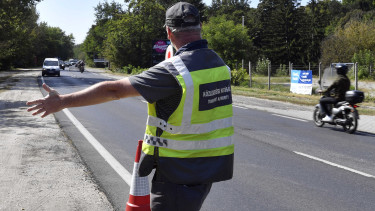Practically all unvaccinated people will get infected by coronavirus - Merkely

The fourth wave of the coronavirus pandemic will certainly burden the health care system less than the previous two, said cardiologist Béla Merkely, who is a member of Prime Minister Viktor Orbán’s epidemiological team of experts.
He told InfoRadio that
We will not see the type of curve we saw during the second and third waves, rather than a elongated, flatly rising curve.
The Delta variant is extremely contagious and will find the people that are not vaccinated, he said. Merkely added that vaccination coverage and immunity via infection are relatively high, but herd immunity cannot be reached therefore
practically all unvaccinated people will contract the virus.
As regard the timing of the third doses (or booster shots), he said elderly people and those with chronic diseases should get it six months after their second dose.
Naturally, the virus can change therefore these rules can also change
, he warned.
Merkely also noted that the surge in new COVID-19 cases in Romania is mainly attributed to the low number of vaccinated people, but he said travel is safe to countries where the number of new confirmed daily cases has been decreasing. He advised against visiting countries where a new coronavirus variant emerged.
Some of Béla Merkely’s previous remarks regarding the fourth wave of the pandemic
- May 23 (TV2)
"There will not be a fourth wave now or in September, there cannot be a mutation that will trigger another epidemic in Hungary, as the infection and vaccination are also very high."
- June 7 (public radio MR1 or Kossuth)
Merkely said he expects that the number of people in hospital will continue to decline, and the number of daily deaths will drop to single digits shortly, and then the epidemic will “completely disappear” over the summer.
“Where vaccination is as high as in Hungary, there will be no fourth wave.”
- July 14 (public television)
"I do not expect a fourth wave where we will need restrictive measures.
"The fourth wave will not start for a long time, there is still time to vaccinate the three million Hungarians that could not be convinced so far."
- 6 August (Facebook)
"There will be no further Covid waves that match up to the magnitude of the last two." Merkely considers this safety to be thanks to Hungary’s high vaccination rate and the fact that many people have already recovered from the virus.
- 23 August
Face masks are less effective against the delta variant of the coronavirus.
A word about Merkely’s vision of a gradual worsening of the epidemic situation
As we warned in a previous article in mid-September, where we compared the current situation with the one a year ago, if this is the ‘wave’ of those that are unvaccinated, it is going to be a big one.
About 60% of the population (or 65% of the adult population) are vaccinated against coronavirus and about 80% of the vulnerable population (60+ years of age) are also inoculated.

Possible scenarios
- We are way ahead in relative time, and this is actually a ‘wave’ of unvaccinated people, in which case the numbers will skyrocket shortly. This is the official narrative. Well, not in Hungary, but globally. The Hungarian government believes in Scenario 3. Controversially, this is actually the best-case scenario. If the situation worsens substantially and suddenly, the Delta variant will not last so long. On the other hand, if we are in Scenario 2 (see next) and the situation keeps worsening gradually and for an extended period, then there will be a lot of casualties.
- This ‘wave’ is affecting everyone, only those that had their shots stand a better chance of avoiding severe symptoms and have a higher chance of surviving an infection. This is practically a new epidemic that we can label as another wave in the pandemic. In that case there will be no sharp rise in the numbers, and the ‘wave’ will have a similar shape as last year only it will go higher. This is the worst-case scenario.
- Everything will be just fine, because a) we are ahead in relative time, and b) vaccines (all of them, for each age group) and cross-immunity also need to be factored in and matter a lot. In this case, the numbers should start to ebb soon.
Based on data available in mid-September the conclusion was that we are likely in some kind of a combination of scenarios 1 and 2. Date since then confirmed this assumption. If it was the third scenario then we should have already seen a significant drop in the number of COVID-19 patients in hospital, in ICUs (on ventilator) and in the number of fatalities. It did not happen.
The wave of the unvaccinated?
About 60% of the Hungarian population (total, see table above) are vaccinated against COVID-19, and the cabinet relies virtually solely on the efficacy of jabs. It has not tightened restrictions despite the rising number of cases and the fact that the situation in terms of hospitalisations and patients needing mechanical ventilation is worse than a year ago.

In comparison, 64% of Israel's population and 66% of the UK population are fully vaccinated, while 55% of the U.S. population are fully protected.

Despite their higher vaccination coverages (except for the U.S.), the 7-day rolling averages of daily new confirmed COVID-19 case (per million people) is way higher in the U.S., Israel and the UK than in Hungary.
Yet, the reproduction rate (R) of COVID-19 is the highest in Hungary among these four countries. In fact, only Hungary's R0 is north of 1, i.e. the virus keeps on spreading.
The case fatality rate is also the higest in Hungary.
The key metric in the current 'wave' is not the number of new cases, rather than the number of COVID-19 patients hospitalised and on ventilator, as well as the number of coronavirus-related deaths, of course.
In this respect, we are worse off than a year ago, as the charts below also attest.

Cover photo: MTI/ Zoltán Balogh






